Tails of the ER
Catch of the Day: The Story of a Dog and a Fish Hook
By Dr. Jeffrey Haymaker
One April day, Mr. Todd and his son Nicky had set out for an afternoon of fishing. Along with them was their 1 year old pit bull mix, Simba. About 40 pounds with brown and tan markings, she was your typical adolescent pit – full of energy and appetite. With hopes of landing a big catch, the Todds unfortunately ended up hooking something unexpected that day. 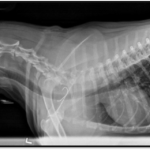

The Todds took Simba to an emergency veterinarian that day with hope of having the hook removed. Simba, being the happy dog that she was, didn't seem to mind the hook except for when she swallowed, letting out a whimper each time. The vets were concerned about the hook being caught in her throat and wanted to do an endoscopic procedure to remove it, but were unable to perform the procedure for another week. Disappointed, the Todds took Simba to a second veterinarian who also could not do the endoscopy, but did take x-rays of her chest and abdomen, revealing the single hook lodged at the base of her neck within her esophagus.
After making several calls, the Todds and Simba finally ended up making an emergency visit to Mount Laurel Animal Hospital, where they met Dr. Jeffrey Haymaker. After reviewing the x-rays, Dr. Haymaker agreed that Simba needed an endoscopy, but admitted he wasn't sure if it could definitely be removed by that method. After all, fish hooks are quite effective at staying where they lodge themselves. If it couldn't be removed, Simba wound need thoracic surgery, which is a much more dangerous procedure. Understanding that this was not an option for the Todds, Dr. Haymaker proceeded with the endoscopy, knowing this was Simba's only chance.
Fortunately for Dr. Haymaker, his colleague Dr. Colin McDermott, a veterinarian for exotic species, had participated in several endoscopies to remove fish hooks from sea turtles when he worked at the National Aquarium. In order to perform the procedure, Simba had to be fully anesthetized. Once under anesthesia, the endoscope, which is a tubular and flexible narrow camera, was placed down Simba's throat into her esophagus. The fish hook was located deep within the wall of the esophagus, much deeper than Dr. McDermott had seen before. Drs. Haymaker and McDermott were very concerned about their chances of dislodging the hook, but fortunately there was still fishing line attached to the hook. In sea turtles, one method of hook removal is to place PVC pipe over the fishing line to use it as a guide to get down to the hook, and then pushing down on the pipe to back the hook out of the wall of the esophagus.
An instrument used to grab on to objects with the endoscope called a "raptor" was inserted through the scope to grab on to the fishing line. With Dr. McDermott driving the scope and Dr. Haymaker using the raptor, they were able to bring the fishing line up to the back of Simba's throat. Without a long enough PVC pipe available, Dr. Robert Mankowski was able to locate a hollow aluminum rod which he guided over the line. Pressure was applied for a few seconds when suddenly tension on the line was lost and it was realized that the fishing line had snapped. Concern and doubt set in as the team worried about their odds of removing the hook if there was no line left. Dr. McDermott placed the scope back in the esophagus to assess the situation. Much to the team's surprise, the hook had been dislodged from the wall of the esophagus and was now lying flat within it. Dr. Haymaker used the raptor to grab the hook, and very carefully, they were able to pull it up and out of Simba's throat without damaging any other tissue. The area where the hook was lodged was inspected and despite minor bleeding and irritation, did not seem to be seriously damaged.
Simba was recovered from anesthesia and was able to go home within an hour of the procedure being completed. She was discharged to the Todds with pain medication, antibiotics, and a medication to coat her esophagus to help it heal faster. Dr. Haymaker cautioned the Todds to watch Simba closely to make sure she was making a quick recovery in case the hook had caused more trauma than what was apparent with the endoscope. Just as before, Simba hardly seemed to notice that she had just had a hook in her throat. The Todds later told Dr. Haymaker that within 2 days, she was completely back to normal. Simba can't be faulted for having a taste for hot dogs, but she is a very lucky dog as fish hooks can cause serious trauma when swallowed. Fortunately for her, she has a very dedicated family that now knows Simba can't be trusted around hot dogs, especially if there is a fish hook inside it.
Spike - The Blizzard Fire Cat
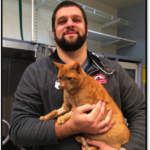

Red Paw Emergency Relief Team and THE EMPATH PROJECT teamed up to cover Spike's medical expenses and help his family in need.
Your Pet (Tried) to Eat What???
As a 24-hour emergency hospital, we've seen all kinds of pets get into crazy things which required emergency surgery to remove from the stomach or intestines. Sometimes, however, the objects do not make it that far into the gastrointestinal (GI) track and end up causing other problems, pushing on the airway and impacting breathing, cutting off circulation to the tongue, affecting the teeth, etc. Below are a few cases where these objects never made it past the mouth but still caused a world of problems.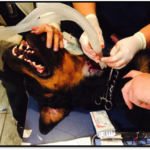

A young rotweiler was playing out back with a lacrosse ball when he suddenly began gasping for breath. His owners watched him turn blue before their eyes. He was rushed to our emergency room where a lacrosse ball was found lodged in the back of his throat. The ball was so slippery it could not be grasped. He was immediately sedated and an emergency tracheostomy tube was placed lower down on his windpipe to enable him to breath while the ball was removed. Despite several attempts at removing the ball, a screw was eventually drilled into the firm ball, enabling us to use the screw to pull the ball out of his throat. He recovered well from this scary ordeal.
A conjure was playing in a dog crate temporarily while his owners cleaned his primary cage. A carabineer was hanging from 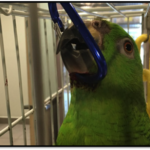

J Gar's Story
J Gar, a 20 year old Barn Owl, is a resident at the Academy of Natural Sciences of Drexel University where he helps with education events for the public. His keeper, Lisa McGonagle, carefully tracks his health and well being. She astutely noticed that he had developed foul-smelling breath, and despite eating he was not producing a normal pellet. Because owls cannot chew their food like mammals, they ingest their prey whole. As a result, several hours after eating, the indigestible parts (fur, bones, teeth, and feathers) are compressed into a pellet. This pellet is normally regurgitated 10-12 hours after ingestion.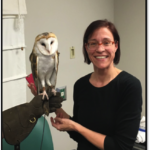

J Gar was taken to Mount Laurel Animal Hospital and Emergency Service where the doctors feared that this pellet was lodged and causing an obstruction. He was placed under anesthesia by Dr. Margaret Fordham, a residency trained exotics expert, and then Dr. Victoria Byfield, an internal medicine doctor, carefully navigated an endoscope through J Gar's mouth and down his digestive track. A large pellet was identified, and then carefully removed with the endoscope. An area of inflammation was identified within J Gar's proventriculus, and biopsy samples were obtained. These samples were for histopathology which revealed inflammation, and fortunately, no additional signs of disease. J Gar is recovering well from his procedure.
Chase's Story
On March 5, 2014, Chase, a 5 month-old Labrador Retriever was out playing in the yard when his owners noticed that he was having trouble breathing. He was rushed to his family veterinarian who determined that Chase required more in depth care and monitoring and was immediately referred to the Mount Laurel Emergency Service. On his ride over to Mount Laurel Emergency Service, it became apparent that his condition was rapidly deteriorating with each second. When Chase arrived at the hospital, his neck was extended as he struggled to breathe; he was quickly rushed into the main treatment area where a team of nurses ascended on him to begin life saving measures.
An IV catheter was immediately put in place. Dr. Torre assessed his condition and ausculted his heart and lungs, revealing muffled lung sounds. His condition continued to deteriorate, so he was sedated to permit intubation (insertion of a tube into the wind pipe), allowing the staff to mechanically breathe for him. His vitals slowly returned to normal with each breath administered by the nurses. 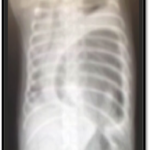

A diagnostic workup was initiated to determine the root of the problem. As Dr. Torre examined the x-ray pictured below, the problem immediately became apparent – Chase was diagnosed with a diaphragmatic hernia, an uncommon condition in which abdominal organs are displaced into the chest cavity. Because the abdominal organs are pressing on the lungs, the lungs are prevented from expanding normally. Within minutes, Chase was prepped for surgery and moved into the Operating Room. His vital parameters were carefully monitored throughout the procedure. Once in surgery, Dr. Torre was able to gently pull the stomach through a hole in the diaphragm and place it back into its normal location within his belly. A large amount of blood was found in Chase's chest cavity, and upon closer inspection, the spleen was also found in the chest cavity. The blood vessels connecting to the spleen had torn which likely occurred when the stomach filled with gas and became distended, pulling on the vessels. Dr. Torre carefully controlled the bleeding and also performed a splenectomy (removal of the spleen). The spleen of dogs is an organ that helps with red blood cell storage, production, and filtration. Dogs do very well without a spleen and because of the compromised blood flow removal of the spleen was not a concern. The defect in the diaphragm was sutured closed, and a chest tube was inserted post-operatively to ensure that all fluid and air within the chest could be carefully drained as Chase began to recover.
Chase recovered under close supervision in a special ICU cage where the temperature and oxygen level of his environment was carefully controlled. Continuous electrocardiograms, blood pressure readings, and other important vitals were all monitored and tracked as Chase recovered from surgery. By hour 14, Chase was up and bouncing around in his cage. He was a new dog!
Chase had a very speedy recovery and was discharged after 48 hours in the hospital. He is now over 100 pounds and happy and healthy!
